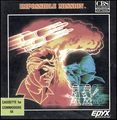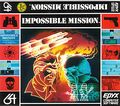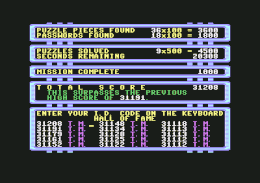Impossible Mission
| Impossible Mission | ||
|---|---|---|
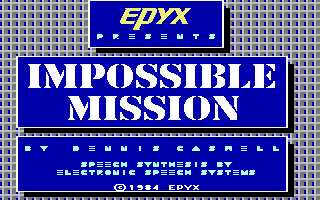
| ||
| Game No. | 2 | |
| Voting | 8.59 points, 101 votes | |
| Developer | Dennis Caswell, Electronic Speech Systems | |
| Company | Epyx | |
| Publisher | Epyx | |
| HVSC-File | MUSICIANS/E/Electronic_Speech_Systems/Impossible_Mission.sid | |
| Release | 1984 | |
| Platform | Acorn Electron, Apple II, Atari 7800, BBC Micro, C64, Schneider CPC, Sega Master System, Sinclair ZX Spectrum, Windows | |
| Genre | Arcade, Platformer (Multi Screen) | |
| Gamemode | Single player | |
| Operation | ||
| Media | ||
| Language | ||
| Information | Successor: | |
Description[edit | edit source]
The situation: for three days have the strategic central computers of the great powers acted up. An unknown person manipulates their programmes; at the end of these programmes is the starting command for the intercontinental rocket. The countdown is on, only 6 hours keep the humanity from an atomic inferno. An unknown person? Only professor Elvin, the insane computer expert could crack the top secret start code, Elvin, who entrenches himself in his intangible subterraneous, guarded by 90 murderous robots, that until now had hunted down every intruder. No one who has ever set foot on the lift to Elvins cave labyrinth has returned back alive.
The last hope: Special Agent 4125, the most cunning, toughest and most indiscriminate man, that the secret service can offer. Only ice cold reckoning and superior physical condition give this unarmed hero a tiny chance to avert the disaster in the last minute.
The game: your task is to put a stop to evil Elvin Atombender's game. For this you have to enter in his laboratory, protected by a vault somewhere on his underground stronghold. To open the laboratory's door you need a nine letters password, each letter of which Elvin coded into a punchcard, just for cutting in four each one of them, painting them in different colors and hiding the resulting pieces everywhere in his base's furniture. So all you have to do is search into every object of every room for pieces of puzzle while surviving the robots, the pits and doctor Elvin's annoying voice, retrieve all the 36 pieces, put them together in groups of four, and head for the laboratory, where an unpleasant surprise waits you.
Design[edit | edit source]
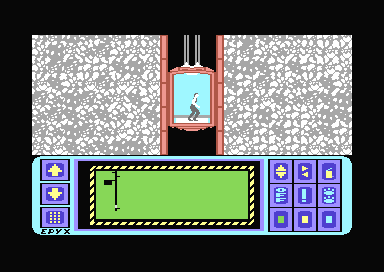 |
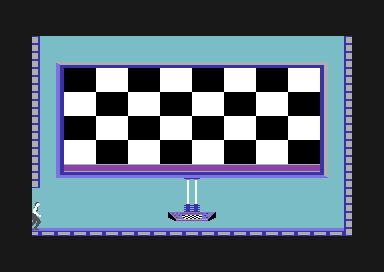 |
The game consists of different screens that are accessed over aisles. Only when going up and down with the lift a vertical scrolling is used.
Speech output can be heard several times, that is when Elvin comments for intimidation (at the beginning of the game: "Another visitor. Stay a while, stay forever...") or instructs his robots in a room ("Destroy him my robots..."). The voice is well imitated from an old professor. The player's character screams realistically, when falling into the abyss.
Sounds are mainly produced by the robots, basic operating noise and the shooting of the laser beams provide a considerable soundscape. The lift makes an appropriate sound when going up and down. When using the modem you can hear dialing sounds and when fitting puzzle parts in the pocket computer you will hear peeping sounds. It is important to mention the sounds, that are played in the two special rooms with the big "chess field" and which need to be clicked in the order of the tone pitch.
The sprites are designed realistically, the main character as well as the robots and the furnishings. The course of movements of the character are precise, so that it is necessary to choose an exact starting position for an accurate jump to reach some of the furniture.
Hints[edit | edit source]
Controls in aisles and rooms[edit | edit source]
- Joystick left/right: character walks left and right
- Joystick up/down: moves the lift and the platforms in the rooms;
- Joystick up: search items; at a computer you can look at the menu with up and then with up/down and fire choose the desired option.
- Fire button (in the aisle in combination with each direction): character jumps
At the computer terminals in the rooms you can switch off the robots for a limited time and -if possible- reset the platforms to the initial position. To use this option you need passwords, that you can
- find just as the puzzle pieces hidden in furniture and other items
- receive by sorting the tones in ascending order in the special "chessboard" rooms (details see below)
Controlling the pocket computer[edit | edit source]
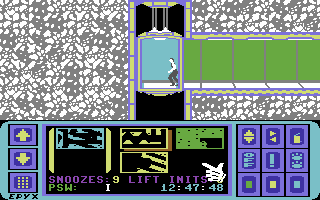
To call it up press the fire button when you are in an aisle or in the lift.
You move the hand with the joystick in the desired direction. By pressing fire you choose or drop a piece and operate the buttons on the left and right side.
At the far left there are two arrows and a keypad. By using the keypad you get into the modem menu, over which you can ask if enough puzzle pieces are collected to solve one part of the puzzle. The other button is to correct the orientation of the puzzle pieces. In the black area (work space) on the left you see all puzzle pieces that you have collected until now. These are placed vertically and can be scrolled up and down by using the arrows. By clicking on one piece a copy is made which can be placed on one of the four fields of the work space. The chosen puzzle piece (shaded) can be changed by the buttons on the right side:
- Change colour (green, yellow, turquoise) with the lower row of buttons
- Turn: horizontally by the button on the upper left, vertically by the button in the upper middle
- A change can be reversed by using the middle button in the middle row (exclamation mark)
- Removed from work space with the button on the upper right (trash bin)
Other functions:
- Pause mode with the button on the far right in the middle row (paws)
- You leave the pocket computer by the left button in the middle row ("Off")
To fully solve the puzzle and with it receive the password, you need to have altogether 36 puzzle pieces. The 4 used pieces per letter disappear from the inventory when placed together correctly.
In the lower line you can see the special pieces for the manipulation of the robots (snoozes) and the platforms (lift inits) you have collected until now, and below that the already solved parts of the password and the current time (starts with 12:00:00).
The put 4 puzzle pieces correctly together they need to have the same colour. The colour they get depends on the colour of the room you find it in. It is advisable to create noticeable patterns with 2 parts, whose counterpart is most of the time easier to put together (subjective view). Generally it is time saving to search for all puzzle pieces before you start to make combinations (so you can be sure that you have enough parts for the solution without having to use the modem all the time).
Further information[edit | edit source]

Instead of a fixed number of "lives" you have a time limit (6 hours), to solve the game. When you die, you lose 10 minutes of this time. The use of the modem costs 2 minutes.
In two rooms you can find a computer terminal with a giant screen with a chess board pattern. When operating the computer, it plays a tone sequence, which need to be replayed in ascending tone pitch. On success you receive a password (for lifts and robots, no puzzle pieces). The more often you have elicited a password from the computer, the longer the tone sequence gets (I think I remember right, that every computer has a separate counter for the current level of difficulty). If you want to stop, you can leave the computer by clicking on the purple bar below the chess board.
With Restore you abort the current game and start a new one.
Versionsinfo[edit | edit source]
There was an original NTSC version and later an original PAL version.
The differences: In the NTSC version you get zapped, if you play it on a PAL C64 and a robot shoots into the left wall. In the ending sequence seen on a PAL C64 there are slight graphic mistakes. The later released PAL version was changed, so that the robots do NOT shoot at the left wall any more. The graphic bugs in the end sequence were fixed.
Solution[edit | edit source]
As the arrangement of the rooms and the allocation of the behaviour of the robots are always random, there is no general solution, but only hints.
The enemies[edit | edit source]
The robots
Robots will chase the player in almost each room. Contact with the robots' chassis or electric beam will kill the player. Even though the robots may all look alike, their behavior differs. Each robot will act according a mix of different abilities:
- can or can't shoot;
- can shoot at designated spots, toward the player, at designated spots and toward the player, or toward the player at the edges of a platform;
- can or can't turn;
- can or can't detect the player;
- can detect the player when he enters the room, when he is in front of them at about the same altitude, or only when he is in front and them and touching with his feet the robot's floor;
- can detect the player as soon as those conditions apply or after a delay;
- can or can't move;
- can move independently, after detecting the player, or only as long as he sees the player;
- can move slow, very slow, fast or very fast;
- can or can't move faster when heading toward the player;
- can or can't change speed according it's heading right or left;
- can or can't turn back while advancing to see if the player is behind them;
- can either shoot or move when detect the player;
A combination of these different behaviors are randomly assigned to each robot at every start of a game (starting position and number of robots in the rooms stay the same). This necessarily has effects: a certain room in which you could search all objects relatively undisturbed might after a new start be much harder to do by the newly "programmed" robots. In the worst case the robots need to be deactivated with a password to be able to search all objects.
The black balls
In 6 rooms there is a black ball whose touch will kill the player. As soon as the player enters in 5 of such a room, the ball will slowly start to follow him to destroy him. You can use this - rather predictable - behavior and lure the ball into the reach of a robot. The ball will be destroyed as soon as it touches a metallic robot. In the sixth room the black ball flies in the shape of an horizontal "eight", in this case you can only avoid it. The black balls will be frozen by using a snooze, but remain deadly to the touch.
The final password
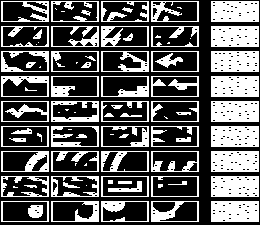
Once you recovered all the pieces of the puzzle you can go to an elevator or one of the aisles and activate the pocket computer. Its options are self-explanatory by their pictograms. The computer allows you to manage the pieces, merge them in punchcards, and decode the resulting letters. Your task is to merge in the computer's interface matching pieces by groups of 4, hoping to form a punchcard that will reveal 1 letter of the password.
In the game there are 8 possible passwords: "ARTICHOKE", "CROCODILE", "CORMORANT", "SWORDFISH", "ASPARAGUS", "ALLIGATOR", "ALBATROSS" and "BUTTERFLY", which cover 21 of the 26 letters of the English alphabet. However, 2 identical letters in a word will be coded with different punchcards, and their 4 pieces won't look alike. There's no obvious relation between the pieces' shape and the letter they will form, nor they will necessarily repeat from one game to another.
A complete punchcard looks like a colored rectangle. In order to obtain 4 pieces from it, the game's program cuts the rectangle in 2 parts along 1 or more lines, that can be fairly straightforward or rather complex. A graphical depiction of such an action could be to divide a flat dough with a confectioner's mold. The result will be a rectangle divided in 2 parts. Then each part will be separately cut again in 2 with other, different, molds, for a total of 4 parts. Each part can be composed by 1 contiguous colored portion or by many separated colored portions, but in both cases will constitute 1 indivisible piece of the puzzle. There are many molds that, combined, create each time different pieces of puzzle. The trouble is that some molds are intentionally used more than once for cutting different punchcards, with the result that a piece can match not only the other pieces of its original punchcard but also sometimes the pieces of other punchcards that were cut at some point with the same mold.


In such a case the estranged piece will match with 1 or 2 pieces of another punchcard but seldom with 3 others, and in this case the punchcard can't be completed. It is possible to successfully match 4 pieces from different punchcards only under rare conditions. If the first mold used to cut 2 different punchcards was the same, then the set of pieces 11-12-13-14 that was obtained with molds A, B and C, and the set of pieces 21-22-23-24 that was obtained with molds A, D and E can be combined in 11-12-23-24 and 21-22-13-14. Usually the human player won't notice this additional possibility, will have the same probabilities to find one combination or the other and the pocket computer will calculate a valid password in either case. If the common mold used was the second, the third, both, or even if it was the first one for one punchcard and a subsequent for another punchcard, then some pieces from different sets may match, but won't form a complete punchcard. Once this problem discovered, the only solution is to discard the combined pieces and start the work from the beginning.
Additionally, the pieces are randomly flipped around their vertical and horizontal axis, and are painted according the color of the room in which they were left.
The upper-right image shows an overview of 9 of the available punchcards and the pieces they were cut in for a particular game. The pieces on the image are already correctly oriented, but are not arranged according the order in which they where obtained from the original. You can note how some sets share a common mold, but never the first one for both: 11-12-13-14 and 81-82; 12-13 and 73-74; 41-44 and 51-52-53-54; 31-32-33-34 and 61-64; 33-34 and 42-43. Also, some molds intentionally resemble each other in order to confuse the player, like those used to obtain 61-62-63-64 and 81-82-83-84.
In a game, there are 36 pieces, each one can be oriented in four directions and painted in three colors, which gives 432 variations.
In order to merge the pieces they have to be of the same color, is not important which one, and an option in the computer allows you to change it. They must also be oriented in a common direction, is not important which one, and still an option in the computer allows you to flip them horizontally or vertically. You can also ask the pocket computer to correctly flip the pieces with the help of its modem. This will set 2 pieces at a time and consume 2 in-game minutes per call. If you complete a punchcard it means its four pieces are oriented in the same direction, but not necessarily the good one. In this case you only have to flip the completed punchcard and once it's correctly oriented it will automatically be accepted by the computer.
There's no easy way to see if 2 pieces can fit together. You can just look at their shape and try to guess if they were cut or not with the same mold, knowing they can be flipped. 2 compatible pieces shouldn't overlap, but the fact they don't overlap is not a guarantee they belong together.
The rooms[edit | edit source]
Cheats[edit | edit source]
- The version by "Remember" offers next to some cheats (unlimited time, unlimited freeezing of robots and setting back of the lifts, shorten the searching, switch off collisions with robots, view end sequence) also the fix that the NTSC version also works on a PAL C64 without "zap bug".
Voting[edit | edit source]
| Voting of the C64-Wiki-User (10=the best Vote): | ||
| 8.59 points at 101 votes (rank 22). You need to be logged in to cast a vote. | ||
| C64Games | 10 | 26th August 2009 - "Highlight" 19753 downs |
| C64.com | 8,5 | 19th December 2006 - 6208 downs |
| Lemon64 | 8,6 | 26th August 2009 - 264 votes |
| Kultboy.com | 7,88 | 26th August 2009 - 27 votes |
| Gamebase64 | 10 | "Classic!" |
| ZZap64 | 95% | Edition 87/05 |
Reviews[edit | edit source]
Sledgie: „Very nice arcade game from the early years of the C64-games. It's just fun to play and combines several types of games (jump'n run, puzzling, logics). The rooms and puzzles are arranged randomly every time you start a new game, it is very diversified. But partly very hard to play.“
Guybrush: „Nice challenge with a very high frust-factor when one planlessly collecting parts, finding nothing and getting busted every time!“
TheKills: „A game I despaired at with 8-9 years. It was for me just like the title said...but I used to play it over and over again. 9 points for this one.“
Borna: „Optically the best game around for that time. Additionally, a well done mix of skill and puzzling. If one collects enough passwords at the beginning, it IS solveable. 10 points from me.“
Klaws: "A rather difficult game, that you above all have to play through in one go, as you cannot save the score. Graphics and sound are kept rather sober and clear, which serves as an advantage for the game. Loving details as the "search bar" makes it a game clearly beyond the usual standard."
Goondoc: "A master piece of those times. And furthermore one of (if not the...) the games with the longest playing time. From a time when the most games started again after 3 levels. The perfectly animated protagonist of the game was also unique and was recycled by Epxy in further games. (Summer Games / Winter Games) And even today the words of Elvin Atombender echo in the back of my head: Another Visitor....stay a while.....staaaaaayyyyyyyyyyy forever!"
Shakermaker303: "Difficult game, created for the ambitious gamer. Very diversified, with relatively good graphics and nice speech samples. Since I have plunged into an abyss with the character for the first time and heard the yell, I know that also computer creatures feel fright and pains. 9/10"
Robotron2084: "This is the game, which owners of other home computers always begruded us at that time. Game design in absolute perfection. 10 out of 10 points!"
Retro-Schulzi: "This way you can easily turn night into day in front of the breadbox. Except of a few handling deficits an absolute must! 9 out of 10 points!"
Fulgore: "I've played it very often for unnumerable hours but to my shame I have to admit that I have never played it through successfully. However, one of the highlights in my C64 top ten list - therefore full 10 points!"
Mysticus: "An absolute high-class game, speech output and the complete idea is unexcelled for the C64. The game belongs definitely to my top 3 games. 10 out of 10 points."
Blubarju: "An absolute highlight! Everything fits here. From graphics over sound to controls. Clear 10 points from me."
AR: "My brother could play the game so well in the past, that he could complete it without losing even one life. But the game has also a small bug: sometimes it can happen that a robot energizes the wall when entering the room and you lose a life. You have the possiblity to use a 'Snooze', but this only works if you reach a terminal before the robot shoots onto the wall. If such a robot is in the game, the game is unsolvable (if a puzzle piece is hidden in that room). Anyway I give 10 points ;-)"
fux: "With all the variations of the robots and the puzzle pieces you have a different game at every new start of the game. One of the best games that I have ever played and my number 1 at the C64. @AR: Maybe I am your brother? :) With the keyboard at the PC it is easier to control, and I can make it every fourth time without losing a life. The glitch, that you describe has fortunately been removed in my WinVice version. :)"
Monty Mole: "Unfortunately, the puzzle rather drags down the game. The idea to put together punchcards is definitely a good idea. But for a platform game, which Impossible Mission is simply supposed to be, the punch card puzzle is just too difficult. It diminuishs the motivation to even start the game, if you know you are confronted by a chewy, too hard and arbitrary puzzle at the end. If I had paid money at that time for a platformer and stumbled upon a puzzle, I would have been rather angry. From my point of view, this is a real bad game design bumbler which unfortunately drags down an otherwise excellent platformer. A great atmosphere - even after 30 years after its first release - a really dodgy but wonderfully thought-through level design and then such a setback. A great pity."
Davidhearnewriter: "In terms of game design, this was so far ahead of the competition. No other arcade, platform puzzler had been seen before. All of the elements came together in something truly incredible, a real experience. I first played it at a friends house and we stayed up all night trying to defeat Elvin and his robots. In 1986 I would come back to finish the game and see that amazing end sequence. Nothing else looks or feels like this gem, it hasn't aged and remains just as addictive and fiendish as it was when first released. Often imitated, never bettered. From the classic animation to the speech and screams, to the cunning robots to the amazing puzzles - this had everything. If perfection exists in a computer game, this is it. 97%"
Miscellaneous[edit | edit source]
Trivia[edit | edit source]
- In 2007 System 3 released a remake for the Sony PSP and the Nintendo DS. Next to the new version also the orignal version can be played.
- Since 11.04.2008 the game is also available as download for the Nintendo Wii Virtual Console.
Cover[edit | edit source]
Advertisement[edit | edit source]
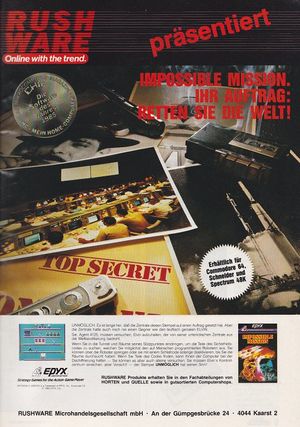 |
Video[edit | edit source]
Highscore[edit | edit source]
Only the Commodore 64 disk version saves highscore table on to diskettes. This features is not available for the cassette version.

- Salvo - 31.726 (28.08.2024)
- Paolo - 31.570 (11.03.2012)
- Tayo - 31.208 (01.12.2009)
- Colt Seavers - 30.058 (09.08.2013)
- Robotron2084 - 23.569 (10.08.2010)
- Blubarju - 20.469 (07.01.2010)
- Mindless - 16.150 (01.01.2019)
- Ivanpaduano - 13.472 (02.07.2018)
- Sledgie - 4.600 (15.10.2009)
- Klaws - 3.700 (02.02.2004)
Links[edit | edit source]
| Wikipedia: Impossible_Mission |
- C64Games.de - Game No. 332
- Lemon64 - Game No. 1283
- Gamebase64.com - Game No. 3731
- C64.com - Game No. 2457
- ready64 - Game No. 30

- Test Report No. 263 on Kultboy.com

- ZZap64 test report
- TheLegacy entry no.4565
- CSDb
- sfodb.com
- C64endings
Videos[edit | edit source]
- Download Video at C64-longplays.de 65,5 MB
- Video at YouTube (complete Longplay)
- Video recording on DailyMotion (*cut 20 minutes version*)

